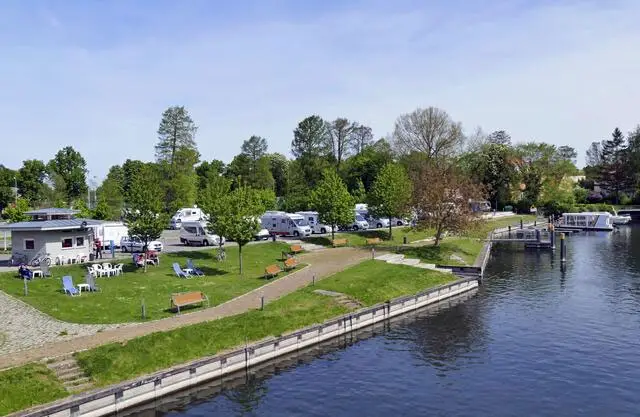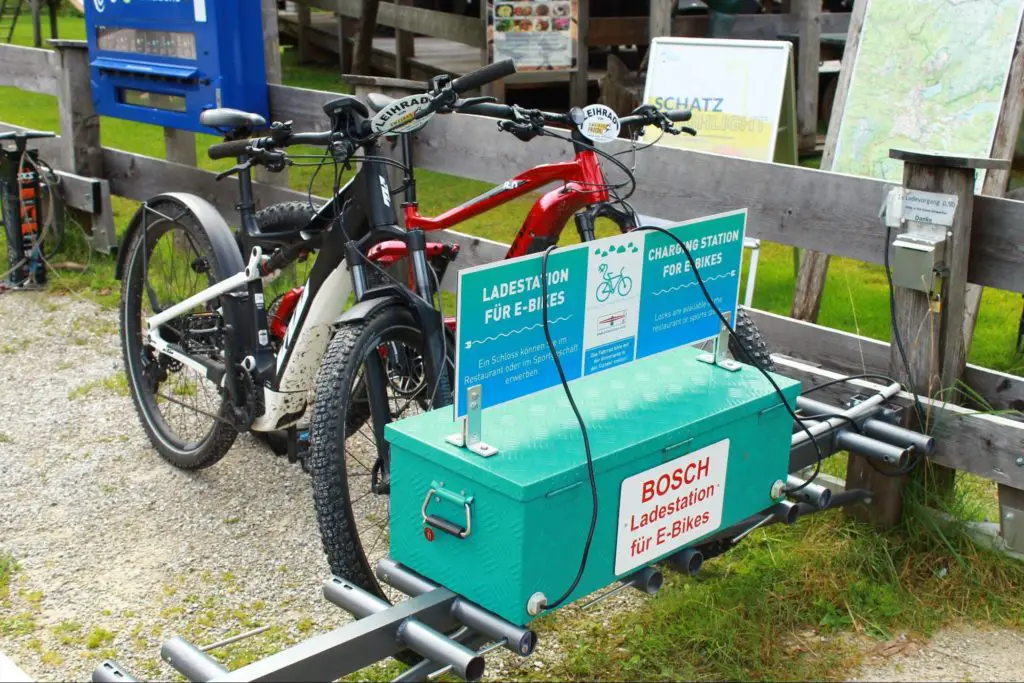Hi-van is supported by its audience. When you purchase using our links, we may earn an affiliate commission (no added cost to you). Learn more
If you’re an RV user, you would already know that RV life is nomadic, which also means that you should ideally have several charging options at hand for your e-bike.
In this article, we’ll discuss 5 easy and effective ways to charge an e-bike in an RV. Read each method carefully to keep your e-bike charged and ready for action.
Basics of an E-Bike in Terms of Charging
E-bikes come with an electric motor that generates power using a built-in battery. The batteries and motors of e-bikes are available in a vast array of different power ratings. Typically, an e-bike has a motor with a size ranging from 250 to 1,000 watts.
There are two different types of motors available for e-bikes, including center-mounted hub-drive and hub-mounted motors. A center-mounted hub drive motor drives the bike-s pedal crank assembly to help the rider. Whereas, a hub-mounted motor drives the front or rear wheel hubs to move the e-bike.
The batteries of e-bikes can vary in watts, amps, and voltage. The standard battery voltage ratings that most manufacturers offer range from 36 to 72 volts.
You need to use the proprietary smart charger that comes with the e-bike to charge the battery. The e-bike charger is usually powered by 120-volt AC, which means you can plug it into the wall outlet to charge the bike.
There are different battery types that an e-bike can have, such as lithium iron phosphate, nickel, and lead-gel. However, lithium-ion is the most common type of battery that these products use. Generally, an e-bike with 15 watt-hours of battery energy will allow you to ride it for about 22 miles.
How Much Power an E-Bike Needs to Charge
Before getting into the details of different methods to charge an e-bike, it’s important to discuss the amount of power your e-bike will need for charging. The required power can vary depending on the e-bike’s model and brand.
A large e-bike will have a bigger battery and it’ll allow it to carry more weight, cover a longer distance, and reach high speeds. In this case, you’ll need more power to charge your e-bike.
For example, if you have a 400-watt e-bike battery, you’ll need more than 400-watt power to recharge it from 0 to 100 percent.
Generally speaking, most e-bikes need 400 to 800 watt-hours of power to charge the battery from 0 to 100 percent. It will vary a lot depending of your battery's capacity.
Therefore, you’ll need to use a charging method that can deliver more power to fully charge the e-bike’s battery.
Regardless of the power source you use, make sure that you use the charger that came with your electric bike. E-bike chargers aren’t universal, and not every charger can charge all e-bike models.
If you don’t have the charger that came with your e-bike, you’ll need to use one that matches the battery specification of your e-bike. For example, if your electric bike has a 36-volt battery pack with a 15-amp controller, you won’t be able to use the 24-volt charger to charge it.
It also means that each charger will require a different power output. The best way to pick the right charger is to consult the user manual of your e-bike and then look for the charger that meets the specification of your bike’s battery pack.
Most e-bike chargers have specs written on them, allowing you to choose the right product.
Best Ways to Charge an Ebike in an RV
There are several ways to charge an e-bike in an RV and here, we’ll discuss the easiest and most effective ones. It’ll help you choose the one(s) that suits your needs the best.
1. You can charge your Ebik with an Inverter
The first and easiest way to charge your e-bike in an RV is to use an inverter. It’s a device that uses the power of your RV’s battery and converts direct current to alternating current. You need to connect it to the 12-volt socket and it’ll provide you with a 120-volt AC power output.
Whether you have parked your RV at a campsite or are driving it, you can use this method to charge your e-bike. However, you’ll need to ensure that your RV’s battery is fully charged when you’re not driving the vehicle so that you don’t run out of charge.

Some inverters come with a built-in LCD panel that provides you with all the information about your RV’s battery. If you don’t have such an inverter, consider installing a battery monitoring system.
2. Generator
Related Guide: Camper generator size: How big should you go? Can you sleep in an RV with the generator running?
Another easy method to charge your e-bike in an RV is to use a generator. Most generators use gasoline, diesel, or propane to run and convert mechanical energy to electricity. It’s important to note that some generators produce output in DC. But e-bikes have AC motors, which means you’ll need to have AC output to charge your bike.
Therefore, it’s important to make sure that you use an RV inverter generator that provides AC output. Otherwise, you’ll need to install an external inverter to convert direct current to alternating current.
A generator will provide enough power to charge your e-bike and you can also use it to run other appliances and devices that you can in your vehicle.
3. Solar Power
Related Guides: How do solar panels work on a van? (an in depth look)
Using solar power is an efficient way to charge different electronic devices, including your e-bike.
A typical RV solar system consists of solar panels, a solar charge controller, a battery bank, and an inverter. This system will allow you to charge your e-bike in your RV in the same way as charging it using an inverter.
When sunlight hits solar panels, it knocks electrons off the atoms in the silicon material of the panels. It creates an electric current, in DC form, that the wiring, attached to the solar panels, captures.
After that, the inverter converts that direct current to alternating current that’s used to charge the battery bank, which then can be used to charge the e-bike battery.
You’ll need to plug the battery of your e-bike into the solar system’s inverter to charge it. While most RV solar panels are 100 to 400 watts of power, you’ll need to make sure that your system generates enough power to charge the e-bike’s battery.
You’ll also need to consider your inverter’s output and battery bank capacity so that your solar system charges your e-bike’s batteryeffectively.
Generally, you’ll need 500 to 800 watt-hours to charge your e-bike’s battery, depending on its capacity. So, you’ll need a solar power system that generates more power than that.
Additionally, you might also need to turn off other appliances to ensure the amount of charging power that the e-bike’s battery needs.
3. Shore Power in Campsites and RV parks

Most commercial campsites and RV parks offer shore power that allows you to charge your e-bike conveniently. It’s the same method you use at home by plugging the e-bike charger into a wall outlet.
So, if you’re at a campsite or RV park, you can look for a shore power supply to charge your e-bike. However, you’ll need to take your bike out of your RV to use this method.
5. Wall Outlet
There are several places, with a wall outlet, that you can find to charge your e-bike on the go. You might also need to pay a small fee to a person offering this service. The most common places to find a wall outlet on the go include, bike shops, coffee shops, restaurants, public parks, fire stations, and gas stations.

Keep in mind that a person allowing you to use their wall outlet is doing you a favor. So, you’ll need to be respectful and ask politely. If the answer is no, make sure that you accept it with kindness. If you’re in a shop or restaurant, consider buying something from them to show food faith.
FAQs about Charging an E-Bike in an RV
How Much Time Does an E-Bike’s Battery Take to Charge Fully?
The time that an e-bike’s battery takes to fully charge depends on its capacity and the charger’s output. Generally, a fully depleted lithium-ion e-bike battery will take about three to six hours to charge from 0 to 100.
Can You Leave Your E-Bike to Charge Overnight?
Most modern electronics come with the auto-shutdown feature, which allows them to turn off the charging when they’re fully charged. If your bike has this feature, you can leave it overnight on charging. But if it doesn’t come with this technology, charging the battery overnight will affect its health over time.
Does Fully Discharging the Battery Affect its Health?
If your e-bike’s battery is discharged fully during the ride, take it to your RV and start charging it. Keep in mind that batteries have some charging left in them before they stop working. It allows them to stay alive and detect whenever the charger is connected to activate the recharging process.
Keeping the battery discharged for a long time can damage its health and capacity. However, different e-bike manufacturers have different recommendations regarding their batteries. Therefore, the way batteries behave after getting fully discharged can vary greatly from manufacturer to manufacturer.
Final Words
There are multiple ways that you can use to charge your e-bike battery in an RV. Using an inverter that can connect to your RV’s 12-volt socket is the easiest way to keep your e-bike charged in an RV.
The second best method to charge the e-bike’s battery is to use a gas-powered generator. If you can’t use both of these methods for some reason, you can utilize solar power using an inverter system, solar generator, or MPPT boost solar charge controller.
If you’re already on your way and none of these methods are available, you’ll need to go to your nearest RV campsite to charge your e-bike using shore power or look for a wall outlet located in local shops, restaurants, fire stations, or gas stations.


